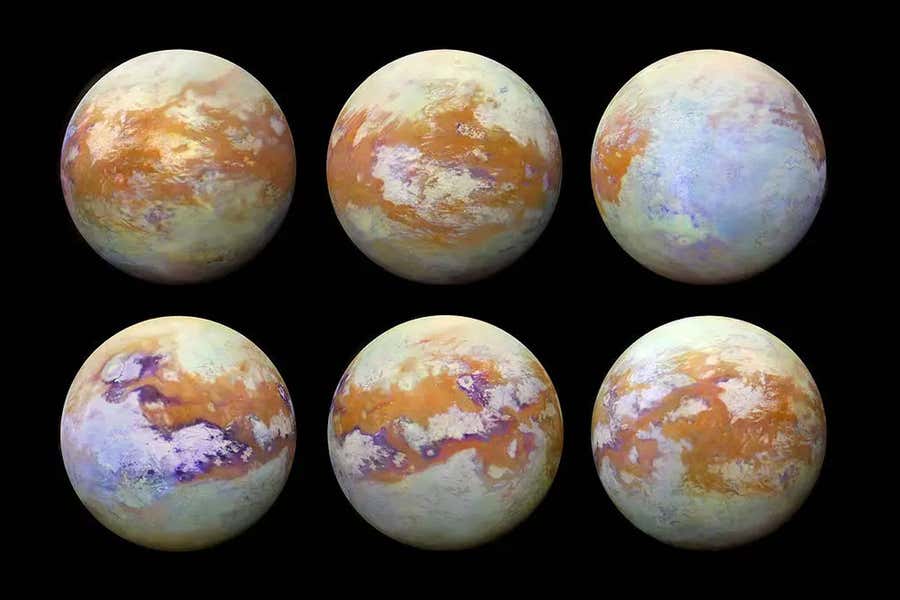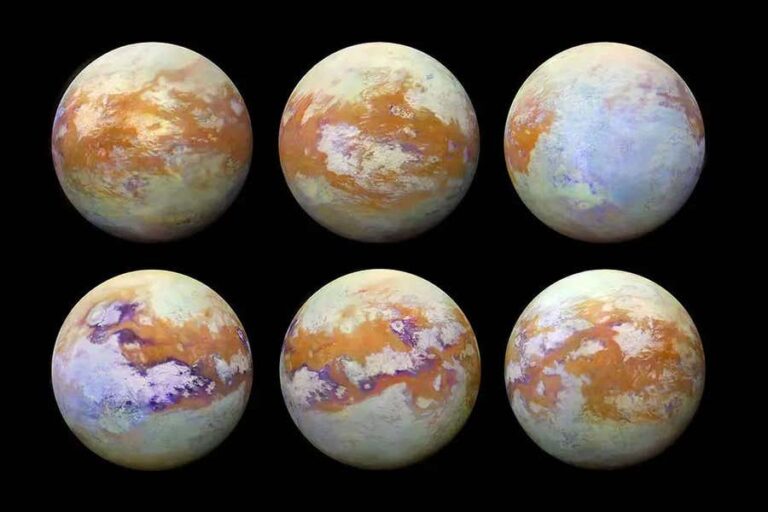Unusual ‘Enchanted Isles’ Detected on Saturn’s Moon Titan Could Be Permeable Icebergs
Scientists have been puzzled for years by the enigmatic “magic islands” that appear and disappear in the methane seas of Titan. These ephemeral features, which continue to baffle researchers, could potentially be composed of peculiar and porous snow formations.
The strange phenomenon of “magic islands” in the seas of Saturn’s moon Titan has intrigued scientists. These islands seem to materialize and vanish within a span of hours to weeks. However, researchers now propose that these so-called islands might actually be porous, sponge-like clumps of snow that gradually fill up with fluid and then sink.

NASA/JPL-Caltech/Stéphane Le Mouélic, Virginia Pasek
Titan’s atmosphere is rich in complex organic molecules that can aggregate and descend to the moon’s surface in the form of snow. Xinting Yu and her team from the University of Texas at San Antonio hypothesized that this “snow” could be responsible for the appearance of the magic islands. To test their theory, they studied the behavior of these atmospheric compounds and their expected interactions with Titan’s seas.
Normally, any solid objects on the surface of Titan’s seas would sink immediately due to the presence of methane instead of water. Unlike water molecules, which tend to stick together and repel other substances, methane readily adheres to other molecules. Consequently, a pool of liquid methane exhibits very little surface tension.
Michael Malaska from NASA’s Jet Propulsion Laboratory in California, who was not involved in this research, explains, “Water molecules have a strong affinity for each other, excluding certain types of molecules. However, when methane is present on the same surface, it spreads easily.” This implies that the methane oceans and lakes on Titan should swiftly engulf any solid materials, even those that would typically float.
However, this contradicts the behavior of the magic islands, which appear as temporary bright spots in observations made by the Cassini spacecraft. “For us to observe the magic islands, they cannot simply float for a moment and then sink,” says Yu. “They must remain afloat for a certain period, although not indefinitely.”
The problem was resolved by the researchers who discovered that if large accumulations of snow gathered on the shore, they could form ice structures with numerous holes, resembling sponges. These porous “icebergs” could then detach from the land and float on Titan’s seas for a sufficient duration to align with the observations made by Cassini. However, this would only be feasible if the sponge-like formations contained a significant amount of empty space, ranging from 25 to 50 percent depending on the specific composition of the ice.
Nevertheless, it is important to note that the presence of porous icebergs does not definitively confirm the nature of the enigmatic islands. Malaska states, “While we are narrowing down the potential explanations for these magic islands, we still do not possess a definitive answer.” Other possible theories include nitrogen gas bubbles, wind-induced waves, or solid sediments in the oceans. Nonetheless, this discovery does provide evidence that the transient islands on Titan could indeed be floating matter originating from the atmosphere of this peculiar celestial body.
Journal reference: Geophysical Research Letters DOI: 10.1029/2023GL106156
Do not forget to share your opinion with us to provide you with the best posts !




0 Comments